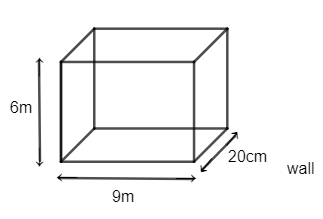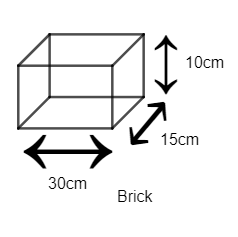Answer
421.2k+ views
Hint: Volume represents the capacity of any solid. Volume of any cuboid with length as ‘l’, breadth as ‘b’ and height as ‘h’ can be given as \[=l\times b\times h\]. Get volumes of brick and wall using the given dimensions. Calculate the total volume of the wall using the volume of brick and number of the wall using the wall using the volume of brick and number of bricks involved to construct the wall.
Now, equate them to get the value of bricks as both represent the same volume of a solid.
Complete step-by-step answer:
We know that wall brick will be of the cuboid shape and the wall is constructed using the bricks. It means the volume of the total number of bricks involved to construct the wall should be equal to the volume of the wall because volume represents capacity of any solid within itself.
Let there be ‘n’ bricks involved to construct the wall of a given dimension.
So, we know the volume of any cuboid with given measurement as
Volume of cuboid \[=length\times breadth\times height\] ……………………………….(i)
Now, we have dimension of wall as
Length \[=9m\]
Height \[=6m\]
Breadth (thickness) \[=20cm\]

Now, we know
\[1m=100cm\]
Hence, length of the wall in cm can be given as
Length \[9m=9\times 100cm=900cm\]
Similarly, height can be given as
\[6m=6\times 100cm=600cm\]
Volume of the wall can be given as
Volume of the wall \[=900\times 600\times 20c{{m}^{3}}\] ………………………..(ii)
Now, we can get volume for brick using equation (i)
So, dimensions of a brick are given as \[\left( 30cm,15cm,10cm \right)\].

Hence, volume of a brick can be calculated as
Volume of a brick $=30\times 15\times 10c{{m}^{3}}$ …..................................(iii)
Now, we have already supposed that ‘n’ bricks are involved for making the wall of given dimensions.
So, the volume of n bricks can be calculated by multiplying ‘n ‘ by the volume of one brick from the equation (iii). Hence, we get
Volume of n bricks $=n\times 30\times 15\times 10c{{m}^{3}}$ …………………………………..(iv)
Now, we know that ’n’ bricks are involved to make the wall, hence volume of both of them should be equal as n bricks are occupying the spaces of the wall.
Hence, from equation(ii) and (iv), we get
$900\times 600\times 20=n\times 30\times 15\times 10$
$n=\dfrac{900\times 600\times 20}{30\times 15\times 10}$
$n=30\times 40\times 2$
$n=2400$
Hence, the given statement is true that the number of bricks required to make a wall of given dimensions by a brick with the provided dimension are 2400.$=n=2400$
Hence, option (A) is correct.
Note: Equating volume of both the rectangular cuboids (bricks and wall) is the key point of the question. One may get confused and he/she tries to equate the surface areas of both of them which is the wrong approach as the surface area of the bricks and wall are not equal as Area does not represent the capacity of any solid.
Conversion of units of any dimension is the key point of the question as well. Try to use ‘cm’ or ‘m’ for representing the dimension, i.e. use only one unit for these kinds of questions.
Now, equate them to get the value of bricks as both represent the same volume of a solid.
Complete step-by-step answer:
We know that wall brick will be of the cuboid shape and the wall is constructed using the bricks. It means the volume of the total number of bricks involved to construct the wall should be equal to the volume of the wall because volume represents capacity of any solid within itself.
Let there be ‘n’ bricks involved to construct the wall of a given dimension.
So, we know the volume of any cuboid with given measurement as
Volume of cuboid \[=length\times breadth\times height\] ……………………………….(i)
Now, we have dimension of wall as
Length \[=9m\]
Height \[=6m\]
Breadth (thickness) \[=20cm\]

Now, we know
\[1m=100cm\]
Hence, length of the wall in cm can be given as
Length \[9m=9\times 100cm=900cm\]
Similarly, height can be given as
\[6m=6\times 100cm=600cm\]
Volume of the wall can be given as
Volume of the wall \[=900\times 600\times 20c{{m}^{3}}\] ………………………..(ii)
Now, we can get volume for brick using equation (i)
So, dimensions of a brick are given as \[\left( 30cm,15cm,10cm \right)\].

Hence, volume of a brick can be calculated as
Volume of a brick $=30\times 15\times 10c{{m}^{3}}$ …..................................(iii)
Now, we have already supposed that ‘n’ bricks are involved for making the wall of given dimensions.
So, the volume of n bricks can be calculated by multiplying ‘n ‘ by the volume of one brick from the equation (iii). Hence, we get
Volume of n bricks $=n\times 30\times 15\times 10c{{m}^{3}}$ …………………………………..(iv)
Now, we know that ’n’ bricks are involved to make the wall, hence volume of both of them should be equal as n bricks are occupying the spaces of the wall.
Hence, from equation(ii) and (iv), we get
$900\times 600\times 20=n\times 30\times 15\times 10$
$n=\dfrac{900\times 600\times 20}{30\times 15\times 10}$
$n=30\times 40\times 2$
$n=2400$
Hence, the given statement is true that the number of bricks required to make a wall of given dimensions by a brick with the provided dimension are 2400.$=n=2400$
Hence, option (A) is correct.
Note: Equating volume of both the rectangular cuboids (bricks and wall) is the key point of the question. One may get confused and he/she tries to equate the surface areas of both of them which is the wrong approach as the surface area of the bricks and wall are not equal as Area does not represent the capacity of any solid.
Conversion of units of any dimension is the key point of the question as well. Try to use ‘cm’ or ‘m’ for representing the dimension, i.e. use only one unit for these kinds of questions.
Recently Updated Pages
Three beakers labelled as A B and C each containing 25 mL of water were taken A small amount of NaOH anhydrous CuSO4 and NaCl were added to the beakers A B and C respectively It was observed that there was an increase in the temperature of the solutions contained in beakers A and B whereas in case of beaker C the temperature of the solution falls Which one of the following statements isarecorrect i In beakers A and B exothermic process has occurred ii In beakers A and B endothermic process has occurred iii In beaker C exothermic process has occurred iv In beaker C endothermic process has occurred

The branch of science which deals with nature and natural class 10 physics CBSE

The Equation xxx + 2 is Satisfied when x is Equal to Class 10 Maths

Define absolute refractive index of a medium

Find out what do the algal bloom and redtides sign class 10 biology CBSE

Prove that the function fleft x right xn is continuous class 12 maths CBSE

Trending doubts
Difference Between Plant Cell and Animal Cell

Difference between Prokaryotic cell and Eukaryotic class 11 biology CBSE

Fill the blanks with the suitable prepositions 1 The class 9 english CBSE

Change the following sentences into negative and interrogative class 10 english CBSE

Summary of the poem Where the Mind is Without Fear class 8 english CBSE

Give 10 examples for herbs , shrubs , climbers , creepers

Write an application to the principal requesting five class 10 english CBSE

What organs are located on the left side of your body class 11 biology CBSE

What is the z value for a 90 95 and 99 percent confidence class 11 maths CBSE



